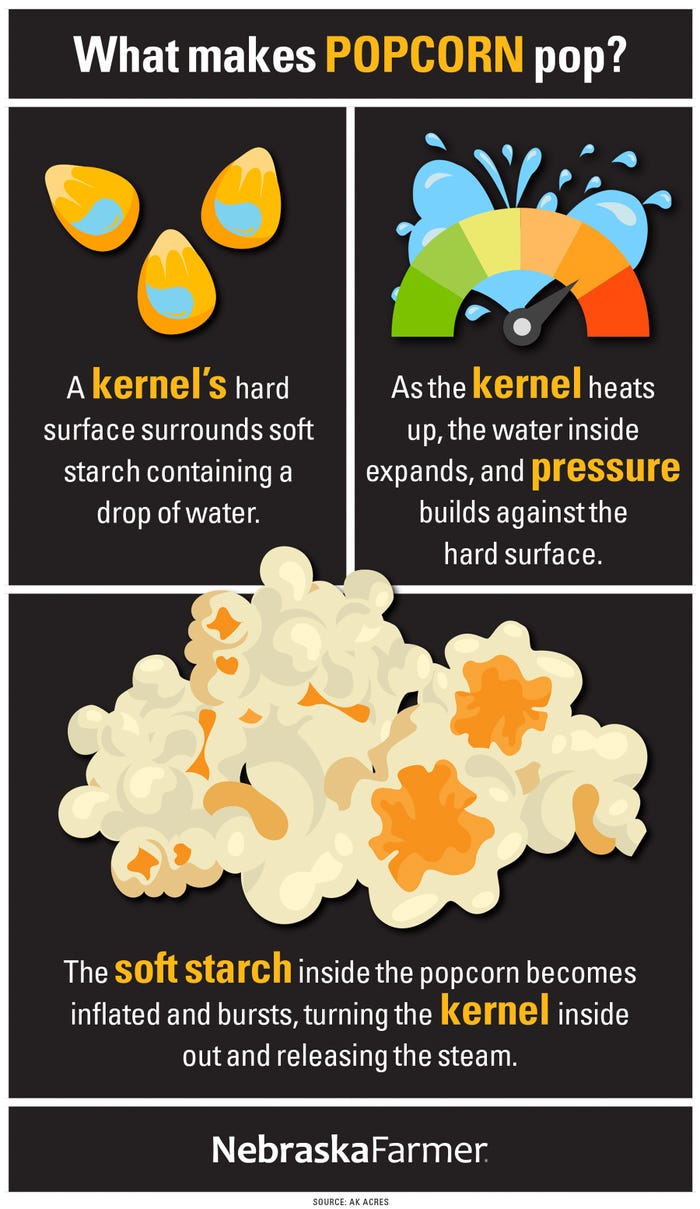
Can you imagine? Americans eat about 17 billion quarts of popcorn every year. That’s enough to fill the Empire State Building 18 times.
Out of that, about 44% — an estimated 353.7 million pounds annually — is produced on about 67,000 acres in 30 Nebraska counties. While other states such as Indiana, in some years, may have more acres planted to popcorn, Nebraska remains the top producer because of irrigation.
High Plains growers
That said, popcorn growers in southwest Nebraska around Imperial had a difficult season in 2022. Dennis Kunnemann — founder of AK Acres Popcorn Co., a bulk supplier of yellow butterfly, yellow mushroom and white butterfly popcorn at Imperial — says that hail in the area was quite severe last season, on top of the extreme heat.
“These two fronts caused yield reduction on acres that had short gallon wells, because rainfall was at record lows,” Kunnemann explains. “Surprisingly, the quality was generally good, except on some of the hailed acres.”
With a grower base within a 50-mile radius of Imperial, and sometimes extending into northeast Colorado, AK Acres growers have a reputation for raising high-expansion popcorn and garnering high yields, which plant breeders attribute to cool nights and sunny days at the high elevations of the High Plains region of the state, Kunnemann says.
“The main reason Nebraska is a good location for popcorn production is the abundance of irrigation, and to a lesser degree, acres of sandy loam soil, which popcorn seems to do well on,” he says.
Most of the producers for AK Acres are veterans at growing popcorn. “Not only are they excellent popcorn producers, but many have experience growing edible beans, sugarbeets, seed crops and other specialty crops,” Kunnemann says.
Growers in southwest Nebraska haven’t experienced excessive disease or insect pressure, but a couple of weeds give them problems. “The most troublesome difficulty is controlling pigweed and waterhemp infestations that continue to expand across the state,” Kunnemann says.
The growers in the High Plains have numerous seed sources, including North Loup, Neb.-based Zangger Popcorn Hybrids, along with Crookham Company in Idaho; Ag Alumni Seed and Weaver Popcorn Hybrids, both in Indiana; and Vogel Seed based in Iowa.
Demand on the rise
Thanks to COVID-19, closure of movie theaters and reduction in demand during that time, there was a large carryover of popcorn inventory that took the company well into 2022.
“Now, it appears demand has returned and, consequently, we will be returning to more normal acres this year, and hopefully beyond,” Kunnemann says.
That is welcome news for the company, which markets to a variety of end users domestically and internationally, with bulk options ranging from tiny 12.5-pound bags and 50-pound bags, all the way up to a bulk forklift bag weighing 2,200 pounds.

Founded in the 1980s by Kunnemann and his father, Arnold, the popcorn company was an extension of their farming operations at the time. Today, they have two processing facilities, and Kunnemann’s son, Seth, is president.
AK Acres has grown into one of the largest on the High Plains, with the capacity to process over 50 million pounds and store more than 70 million pounds of popcorn each year.
Learn more at akacres.com.
About the Author(s)
You May Also Like






